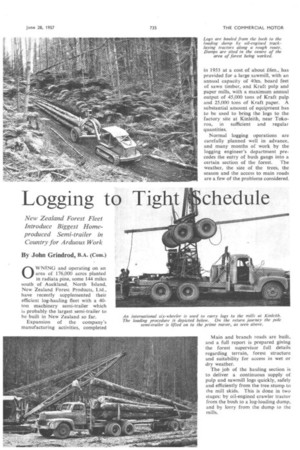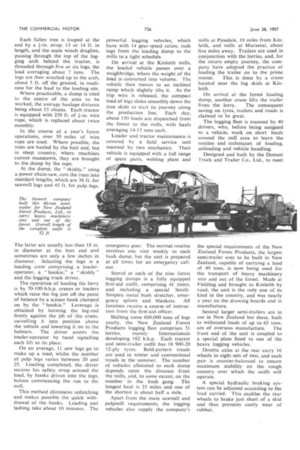Logging
Page 71

Page 72

If you've noticed an error in this article please click here to report it so we can fix it.
New Zealand Forest Fleet Introduce Biggest Homeproduced Semi-trailer in Country for Arduous Work
By John Grindrod, BA. (Corn.) 0 WNING and operating on an area of 176,000 acres planted in radiata pine, some 144 miles south of Auckland, North Island, New Zealand Forest Products, Ltd., have recently supplemented their efficient log-hauling fleet with a 40ton machinery semi-trailer which is probably the largest semi-trailer to be built in New Zealand so far.
Expansion of the company's manufacturing activities, completed in 1953 at a cost of about £6m., has provided for a large sawmill, with an annual capacity of 40m. board feet of sawn timber, and Kraft pulp and paper mills, with a maximum annual output of 45,000 tons of Kraft pulp and 25,000 tons of Kraft paper. A substantial amount of equipment has to be used to bring the logs to the factory site at Kinleith, near Tokoroa, in sufficient and regular quantities.
Normal logging operations are carefully planned well in advance, and many months of work by the logging engineer's department precedes the entry of bush gangs into a certain section of the forest. The weather, the size of the trees, the season and the access to main roads are a few of the problems considered.
Main and branch roads are built, and a full report is prepared giving the forest supervisor full details regarding terrain, forest structure and suitability for access in wet or dry weather.
The job of the hauling section is to deliver a continuous supply of pulp and sawmill logs quickly, safely and efficiently from the tree stump to the mill skids. This is done in two stages: by oil-engined crawler tractor from the bush to a log-loading dump, and by lorry from the dump to the mills.
Each fallen tree is looped at the end by a /-in. strop, 13 or 14 ft. in length, and the main winch dragline, passing through the top of the logging arch behind the tractor, is threaded through five or six logs, the load averaging about 7 tons. The logs are then winched up to the arch, about 5 ft off the ground, in readiness for the haul to the loading site.
Where practicable, a dump is sited in the centre of the area to be worked, the average haulage distance being about 15 chains. Each tractor is equipped with 230 ft. of 4-in. wire rope, which is replaced about twice monthly.
In the course of a year's forest operations, over 50 miles of wire rope are used. Where possible, the trees are hauled by the butt end, but in steep country, where machines cannot manceuvre, they are brought to the dump by the tops.
At the dump, the " skiddy," using a power chain-saw, cuts the trees into standard lengths, which are 36 ft. for sawmill logs and 45 ft. for pulp logs.
The latter are usually less than 18 in. in diameter at the butt end and sometimes are only a few inches in diameter. Selecting the logs is a loading crew comprising a loaderoperator, a " hookie," a " skiddy " and the logging truck driver.
The operation of loading the lorry is by 70-100-b.h.p. cranes or loaders which raise the log just off the point of balance by a scissor-hook clamped on by the " hookie." Leverage is obtained by hoisting the log-end firmly against the jib of the crane, swivelling it into position above the vehicle and lowering it on to the bolsters. The driver assists the loader-operator by hand signalling each lift to its place.
On an average, 11 saw logs go to make up a load, whilst the number of pulp logs varies between 20 and 25. Loading completed, the driver secures his safety strop around the load, by hooks driven into the logs, before commencing the run to the mill.
This method eliminates unhitching and makes possible the quick withdrawal of the hooks. Loading and lashing take about 10 minutes. The powerful logging vehicles, which have with 14 gear-speed ratios, rush logs from the loading dump to the mills to a tight schedule.
On arrival at the ICinleith mills, the loaded vehicle passes over a weighbridge, where the weight of the load is converted into volume. The vehicle then moves to an inclined ramp which slightly tilts it. As the trip wire is released, the compact load of logs slides smoothly down the iron skids to start its journey along the production line. Each day, about 150 loads are dispatched from the forest to the mills, with hauls averaging 14-15 tons each.
Loader and tractor maintenance is covered by a field service unit manned by two mechanics. Their vehicle is equipped with a full range of spare parts, welding plant and emergency gear. The normal routine involves one visit weekly to each hush dump, but the unit is prepared at all times for an emergency callout.
Stored at each of the nine forest logging dumps is a fully equipped first-aid outfit, comprising 41 items, and including a special SmithSimplex metal bush stretcher, emergency splints and blankets. All foremen receive a course of instruction from the first-aid officer.
Shifting some 600,000 tons of logs yearly, the New Zealand Forest Products logging fleet comprises 51 lorries, mainly Internationals developing 162 b.h.p. Each tractor and semi-trailer outfit has 18 900-20 12-ply tyres. Bold-pattern treads are used in winter and conventional treads in the summer. The number of vehicles allocated to each dump depends upon the distance from the mills, and, to some extent, on the number in the bush gang. The longest haul is 23 miles and one of the shortest is about half a mile.
Apart from the main sawmill and pulpmill requirements, the logging vehicles also supply the company's mills at Pinedale, 19 miles from Kinleith, and mills at Maraetai, about five miles away. Trailers are used in conjunction with the lorries, and, for the return empty journey, the company have adopted the practice of loading the trailer on to the prime mover. This is done by a crane located near the log skids at KinLeith.
On arrival at the forest loading dump, another crane lifts the trailer from the lorry. The consequent saving on tyres, trailers and roads is claimed to be great.
The logging fleet is manned by 40 drivers, who, before being assigned to a vehicle, work on short hauls around the mill area to learn the routine and techniques of loading, unloading and vehicle handling.
Designed and built by the Domett Truck and Trailer Co., Ltd., to meet the special requirements of the New Zealand Forest Products, the largest semi-trailer ever to be built in New Zealand, capable of carrying a load of 40 tons, is now being used for the transport of heavy machinery into and out of the forest. Made at Fielding and brought to Kinleith by road, the unit is the only one of its kind in the country, and was nearly a year on the drawing boards and in manufacture.
Several larger semi-trailers are in use in New Zealand but these, built to withstand loads of up to 65 tons, are of overseas manufacture. The front end of the unit is coupled to a special plate fixed to one of the heavy logging vehicles.
Double axles at the rear carry 16 wheels in eight sets of two, and each pair is counter-balanced to ensure maximum stability on the rough country over which the outfit will operate.
A special hydraulic braking system can be adjusted according to the load carried. This enables the rear wheels to brake just short of a skid and thus prevents costly wear of rubber.








































































































































